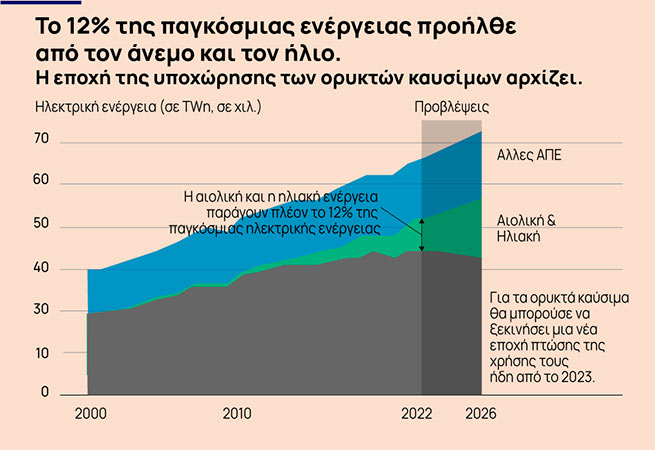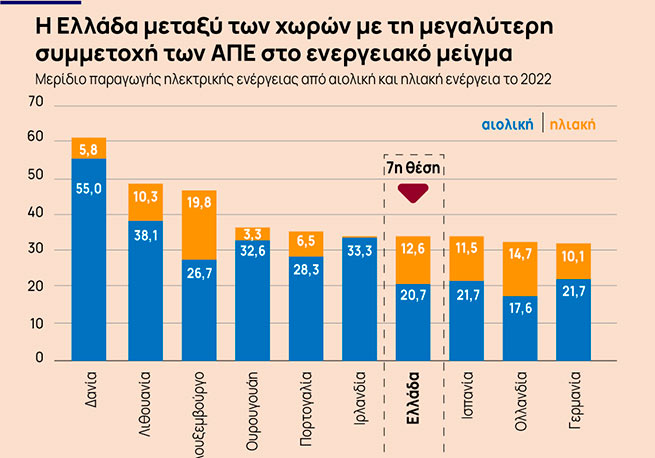Greece occupies one of the highest positions in terms of penetration of renewable energy sources (RES) into the energy mix.
This conclusion follows from Ember’s latest 2022 global energy market report, which set a record for electricity generation from renewables, with PV and wind turbines accounting for 12% of the energy produced.
Greek position
With 20.7% of electricity coming from wind turbines and 12.6% from photovoltaic systems, the total contribution of RES to the Greek energy mix was 33.3%. A percentage that puts Greece in 7th place in the world in terms of the penetration of renewable energy into electricity generation.
top ten
Denmark is in first place with a total percentage of 55.8%, while Lithuania (48.4%) and Luxembourg (46.5%) close the top three. Fourth place is occupied by Uruguay with a share of 35.9%, fifth by Portugal (34.8%) and sixth by Ireland (33.3%), the only country in the top ten whose net energy is entirely generated by wind turbines. Greece is followed by Spain (33.2%), the Netherlands (32.3%) and Germany (31.8%), making up the last three in the top ten.
2022 is a significant year
According to the Ember report, 2022 was a pivotal year in terms of the global community’s transition to clean energy. Solar and wind energy provided 12% of global electricity generation, a record high from 10% in 2021.
If we take into account the participation of nuclear power plants in the energy balance, then 39% of the world’s energy comes from clean energy sources, which is also a historically high record. Solar generation grew by 24% and remained the fastest growing source of electricity for 18 consecutive years (wind generation grew by 17%).

12% of the world’s energy is produced with the help of the sun and wind turbines
As the report highlights, last year’s increase in global solar generation could meet South Africa’s annual electricity demand, while an increase in wind generation could power nearly all of the UK.
Currently, more than 60 countries generate more than 10% of their electricity from wind and solar energy. However, other sources of clean electricity declined for the first time since 2011 due to declining nuclear power generation, fewer new nuclear and hydro power plants coming online.
“In a climate-critical decade, this is the beginning of the end of the fossil fuel era. We are entering the era of clean energy. The stage is ready to bring to the fore the energy of the wind and the sun. Clean electricity will change the global economy, from transportation to industry and beyond. A new era of lower emissions means that coal-based electricity generation will be phased out and the end of gas-based electricity generation growth is just around the corner. Change is coming fast. However, it all depends on the actions governments, businesses and citizens take now to put the world on a clean energy path by 2040.”says Malgorzata Viatros-Motica.
Fossil fuel
Electricity production increased in 2022 (+1.3%), reaching a historically high level. Electricity is cleaner than ever, but we use more. Coal production increased by 1.1%, which is in line with the average growth over the past decade. The “phasing out of coal-fired electricity generation” agreed at COP26 in 2021 may not start in 2022, but the energy crisis has not led to a significant increase in coal burning, as many feared.
Electricity generation from natural gas declined marginally (-0.2%) in 2022 for the second time in three years due to high global gas prices. The switch from natural gas to coal was limited in 2022, as natural gas was already largely more expensive than coal in 2021. In 2022, only 31 GW of new gas-fired power plants were built, the lowest figure in 18 years.
2022 also recorded the fewest shutdowns of coal-fired plants in seven years, the report notes, as countries strive to maintain spare capacity even as the transition period accelerates.
Wind and solar power are slowing down the growth of electricity emissions. If all electricity was generated from fossil fuels, emissions would be 20% higher in 2022. The growth in wind and solar generation alone (+557 TWh) covered 80% of the growth in global electricity demand in 2022 (+694 TWh). Clean energy growth is likely to outstrip electricity demand growth in 2023, the first year that this has happened outside of a recession.
Ember expects that with average growth in demand for electricity and clean energy in 2023, there will be a slight decline in fossil fuel production (-47 TWh, -0.3%) as wind and solar develop further. The report concludes that a new era of emissions reduction in the power industry has arrived.







More Stories
The weather will turn bad on Good Friday
Crete "shaking" – two earthquakes this morning
Ecological… tombstones